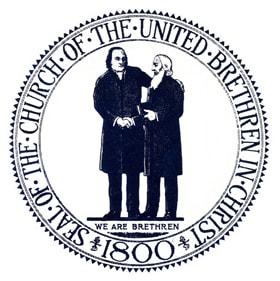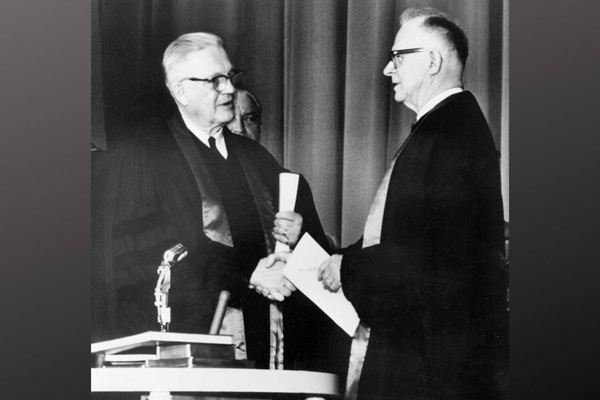If you’ve ever wondered where the “united” in United Methodist Church comes from, you’re not alone. The UMC we know today was born out of the 1968 merger of two pre-existing denominations: The Methodist Church and the Evangelical United Brethren Church. The Methodist Church was directly descended from the ministry of John Wesley, but fewer people know the origins of The Evangelical United Brethren (EUB).
The beginnings of The EUB trace all the way back to the Late 18th Century in Colonial America (at the same time as the early Methodists). The EUB began as two separate religious movements among the growing German immigrant population in the Colonies: The Church of the United Brethren in Christ and the Evangelical Church.
The Church of the United Brethren was founded by German-born missionary Philip William Otterbein and Pennsylvania pastor Martin Boehm.[1] Otterbein was brought up in the German-reformed tradition, while Boehm was raised in a Mennonite (Anabaptist) community outside of Lancaster. Despite coming from very different church traditions, the two men came together in 1767 when Otterbein attended a service at Long's Barn to hear Boehm preach. After the service he embraced Boehm and said in German “We are brothers.”[2] The two co-led a revival movement among Pennsylvania and Maryland’s German-speaking community that held its first conference in 1800, officially forming United Brethren in Christ, which quickly spread to the Midwest.

The Evangelical Church was formed by German-Lutheran pastor Jacob Alright in Lancaster, PA. Albright had begun attending Methodist meetings in the 1790s and was inspired by their zeal and organizational model. He began leading Methodist-style classes among the German-speaking community. Albright’s movement would not take the name Evangelical Association until 1816, eight years after his death. The name was changed to Evangelical Church in 1923.[3]
Though they began as separate movements, the United Brethren and the Evangelical Church were interconnected to each other and the Methodist Episcopal Church through common practices and beliefs as well as bonds of fellowship and mutual respect between its founders. Albright had originally been approved as a preacher within The MEC and Boehm late in life became a member of The MEC even as he continued to lead the United Brethren.[4] Bohem’s son Henry became a preacher within The MEC and even accompanied Francis Asbury on many of his travels.[5]
Both The United Brethren and The Evangelical Church continued to grow and develop over the 19th Century, spreading their ministries into the Midwest. The United Brethren founded Otterbein University in 1847, which is still operating today. Both denominations took a much harder line against slavery than The MEC. Both underwent splits in the Late 1800s over disagreements in polity and organization. The United Brethren gradually abandoned worship in German in favor of English, while the Evangelical Church retained their German roots much longer.
Talks of merging the two similar denominations began in the Early 20th Century. The two united to form the Evangelical United Brethren Church in 1946. Prior to the merger the United Brethren had allowed women to become ordained, but ended this practice at the insistence of the Evangelical Church, which allowed only men serve as elders.[6]
Not long after, talks began with the Methodist Church (formed in 1939) about creating new denomination together. While already sharing a common history and very similar ecclesiology, the EUB was smaller than the Methodist Church, both in terms of membership and geographical reach. There were other more significant differences as well.
The EUB took issue with the Methodists practice of segregating its African American clergy and churches into separate conferences (known collectively as the Central Jurisdiction). Though there were already efforts within the Methodist Church combating racial segregation, the prospect of a merger with the EUB brought added pressure on the larger denomination to abolish the Central Jurisdiction once-and-for-all. Meanwhile, The EUB agreed to recognize women’s ordination in accordance with the Methodist Church’s position.[7]
The two denominations officially came together at the Uniting Conference in 1968 held in Dallas, TX. The merger was signified by the joining of hands between Bishop Reuben H. Mueller of the EUB and Bishop Lloyd Christ Wicke, not very different from the way the original United Brethren began with Otterbein and Boehm embracing as brothers. The new denomination would become known as The "United" Methodist Church, honoring the legacy of the Evangelical United Brethren Church.[8]
Test your knowledge of The Evangelical United Brethren Church by taking this quiz.
This content was produced by UMC.org on April 5, 2024. Philip J. Brooks is a writer and content developer at United Methodist Communications. Contact him by email.
[1] Rowe, Kenneth E.; Richey, Russell E.; Schmidt, Jean Miller. The Methodist Experience in America Volume I: A History. Nashville: Abingdon Press, 2010.
[2] Idem.
[3] Idem.
[4] Idem.
[5] Iovino, Joe. “Martin and Henry Boehm: Founding Brethren of the UMC.” United Methodist Communications.
[6] Rowe, Kenneth E.; Richey, Russell E.; Schmidt, Jean Miller. The Methodist Experience in America Volume I: A History. Nashville: Abingdon Press, 2010.
[7] The Book of Discipline for The United Methodist Church 2016. Nashville: The United Methodist Publishing House, 2016.
[8] “Timeline of The United Methodist Church.” United Methodist Communications





